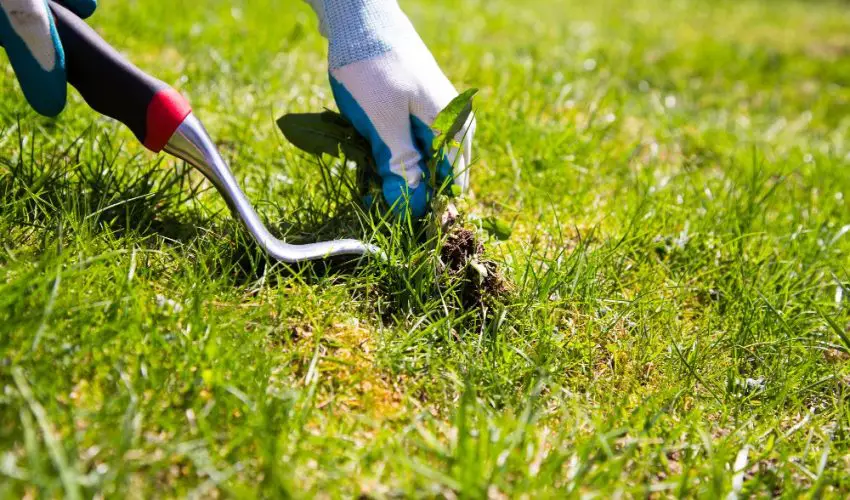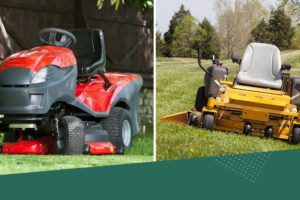The most effective way to get rid of weeds in your lawn is to use a herbicide treatment like Roundup. The downside is that it will kill the surrounding grass leaving brown patches in your lawn. Sometimes that’s not an issue, but if it is then you should go for an organic weed killer based on vinegar instead.
Table of Contents
ToggleHow to tell if you have weeds in your lawn
One of the first signs that you have weeds in your lawn is noticing a sudden change in the appearance of your grass. If you suddenly notice patches of discoloration or yellowing, this could be a sign that there are weeds taking over your yard.
Other common indicators include seeing clusters of weeds growing in the grass, or noticing that you are having to mow your lawn more frequently than usual.
If you suspect that you have weeds in your lawn, it’s important to take action as soon as possible. The first step is to get a better understanding of what types of weeds you are dealing with, and the best way to treat them.
Different Types of Lawn Weeds
There are a variety different types of lawn weeds. Some common examples include dandelions, crabgrass, clover, and thistles.
1. Dandelion
Dandelions are one of the most common types of weed found in lawns. They can spread quickly and produce seeds that are capable of spreading over long distances.
2. Crabgrass
Crabgrass is another common lawn weed that can be difficult to get rid of. It tends to grow in clumps, and thrives in hot and dry conditions, such as those commonly seen during the summer months. If you have problems with crabgrass I’d recommend you to check out this article on how to get rid of crabgrass in your lawn
3. Clover
Clover is a widely-spread weed that often found in the lawn. It tends to spread quickly, and is known for being very resilient. In some cases, it may even require multiple treatments to completely remove clover from your lawn.

4. Thistles
Thistles are a particularly stubborn type of weed that can be difficult to get rid of once they become established in your lawn. They grow tall and produce spiny seed heads that causes a stinging sensation and a rash if it get in touch with the skin.
5. Rye Eye Grass
Rye eye grass is a type of lawn weed that can be difficult to treat. It spreads quickly, and is known for being resilient even in moist conditions.
6. Horsetail Grass
Horsetail grass is a perennial weed that can be difficult to get rid of once it establishes itself in your lawn. It spreads quickly and is known for producing razor-sharp leaf tips, making it particularly problematic if left untreated.
If you are dealing with any of these common types of lawn weeds, it’s important to take action right away. The key is to address them as soon as possible, before they have a chance to spread and become even more difficult to get rid of.
How to remove weeds from your lawn
There are a number of different approaches you can take to successfully remove weeds from your lawn.
1. Pull weeds manually
One of the most basic and effective ways to remove weeds from your lawn is simply by pulling them out by hand. This can be a time-consuming process, but if done regularly it can be an effective way to keep your lawn weed-free.
2. Use a weed killer
If you have a lot of weeds in your lawn the most effective way is to treat the weeds with a herbicide like Roundup. But you can also use a specially formulated weed killer to kill weeds and prevent them from growing back.
| Weed Killer | Active Ingredient(s) | Effectiveness | Safety |
|---|---|---|---|
| Roundup | Glyphosate | Highly effective | Harmful to humans and pets if ingested or absorbed through the skin |
| Ortho Weed B Gon | 2,4-D, dicamba, mecoprop | Highly effective | Harmful to humans and pets if ingested or absorbed through the skin |
| Scotts Turf Builder Bonus S Southern Weed & Feed | 2,4-D, dicamba, mecoprop | Highly effective | Harmful to humans and pets if ingested or absorbed through the skin |
| Preen Garden Weed Preventer | Trifluralin | Moderately effective | Generally considered safe for humans and pets |
| Natural Armor Weed & Grass Killer | Clove oil, citric acid, vinegar | Moderately effective | Generally considered safe for humans and pets |
3. Aerate your lawn
Another method for getting rid of weeds in your lawn is to aerate the soil, which helps loosen up the dirt and allows grass roots to spread more easily. This can be particularly helpful if you have a lot of compacted soil or established weeds that are difficult to remove.
Weed control for a grass lawn
When it comes to controlling weeds in a grass lawn, the most important thing is to be proactive. An effective way to prevent and control weeds is by maintaining healthy soil conditions in your lawn.
This can be done by ensuring that you are regularly watering and fertilizing your grass, as this will help keep it healthy and robust and better able to compete against weeds.
Except to maintaining healthy soil conditions, another key factor in weed control is proper lawn maintenance.
This includes things like mowing and edging your lawn regularly, as well as using a rake or other tool to remove any dead leaves or debris that may be providing a good environment for weeds to grow.
How to get rid of weeds without killing the grass
The best option to get rid of weeds without killing your grass is to use an organic or natural weed killer. This can typically be done by applying a diluted solution of white vinegar, citrus oil, or other natural weed-killing ingredients to the affected areas.
Here’s a video on how to get rid of Crabbgrass and Clover in the lawn without killing the grass.
How to get rid of lawn weeds in winter
If you are dealing with weeds in your lawn during the winter months, one option is to use a specialized pre-emergent weed control product. This helps keeping weeds from sprouting or becoming established, and prevents them from spreading and causing damage to your lawn.
Conclusion
Whether you are dealing with common lawn weeds like dandelions or more stubborn types of weeds like crabgrass, there are a number of ways to get rid of them and keep your lawn looking healthy and beautiful.
The most effective way is to use a specialized weed killer product like Roundup and apply it on the weeds in your lawn. But it’s also important to be proactive by keeping your lawn healthy and well-maintained by watering, fertilizing and mowing regularly to prevent weeds from growing in the first place.





